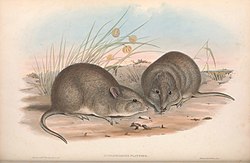| Potoroos [1] | |
|---|---|
 | |
| Potorous platyops | |
| Scientific classification | |
| Kingdom: | Animalia |
| Phylum: | Chordata |
| Class: | Mammalia |
| Infraclass: | Marsupialia |
| Order: | Diprotodontia |
| Family: | Potoroidae |
| Subfamily: | Potoroinae |
| Tribe: | Potoroini Gray, 1821 |
| Genus: | Potorous Desmarest, 1804. [2] |
| Type species | |
| Didelphis murina | |
| Species | |
Potoroo is a common name for species of Potorous, a genus of smaller marsupials. They are allied to the Macropodiformes, the suborder of kangaroo, wallaby, and other rat-kangaroo genera and is the only genus in the tribe Potoroini. All three extant species are threatened by ecological changes since the colonisation of Australia, especially the long-footed potoroo Potorous longipes (endangered) and P. gilbertii (critically endangered). The broad-faced potoroo P. platyops disappeared after its first description in the 19th century. The main threats are predation by introduced species (especially foxes) and habitat loss.
Contents
Potoroos were formerly very common in Australia, and early settlers reported them as being significant pests to their crops.
